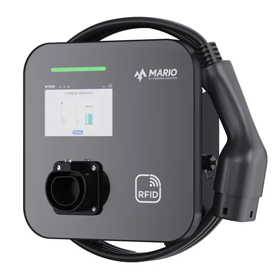Views: 0 Author: Site Editor Publish Time: 2025-05-22 Origin: Site







As electric vehicles (EVs) become more popular around the world, the importance of reliable and accessible public charging infrastructure continues to grow. While many EV owners charge their vehicles at home, public EV charging stations are essential for longer trips, city driving, or when home charging isn't available. Fortunately, the network of public charging stations is expanding rapidly, making it easier than ever to drive an electric car with confidence.

Electric mobility is no longer a futuristic concept — it’s a growing reality. As more people choose EVs for environmental, economic, and practical reasons, the need for public EV charging infrastructure has skyrocketed. To support this shift, governments, private companies, and EV manufacturers are investing heavily in expanding public charging networks.
Public EV charging stations are now found in a wide variety of locations, including:
Parking lots of shopping malls
Gas stations and highway rest areas
Hotels and resorts
Office buildings
Supermarkets
Public parking garages
The goal is to make EV charging as convenient and accessible as refueling a gasoline-powered car. As the number of chargers increases, so does your freedom to travel anywhere in your EV — without range anxiety.
Finding a public EV charger has become significantly easier thanks to dedicated apps, vehicle navigation systems, and map integrations.
Several apps are designed specifically to help EV drivers find available charging stations in real-time. Popular apps include:
PlugShare: A crowd-sourced map with user reviews, ratings, and availability.
ChargePoint: Offers a network of chargers and an app to find stations and start charging sessions.
Electrify America: Provides fast-charging locations with app-based control.
EVgo: Shows fast-charging locations, charger types, and real-time availability.
Tesla App: For Tesla owners, this app shows Supercharger locations and availability.
Most modern EVs come with built-in navigation systems that display nearby charging stations and indicate which are compatible with your vehicle.
Both services now include EV charging stations in their maps. You can search for terms like “EV charging station near me” or “electric vehicle charger” to find options close by.
Websites like OpenChargeMap and local government portals often provide listings of publicly accessible chargers.
To charge your EV in public, it’s important to know which connector types your vehicle supports and what’s commonly available at stations.
Rare in public spaces due to slow charging speeds (2–5 miles of range per hour). Typically found in older or low-use areas.
Common in public parking lots and shopping centers. Offers 10–30 miles of range per hour.
Connector type: SAE J1772 (standard for most North American EVs)
Compatible with: All EVs (Tesla with adapter)
Provides rapid charging — 60 to 100+ miles of range in 20–30 minutes.
Connector Types:
CCS (Combined Charging System): Used by most newer EVs (e.g., Ford, Volkswagen, Hyundai, GM).
CHAdeMO: Mostly used by older Nissan Leafs and Mitsubishi EVs.
Tesla Supercharger: Exclusive to Tesla (non-Tesla use expanding in some areas).
Always check your EV manual or charging app to confirm compatibility. Carrying the right adapter (especially for Tesla owners) ensures flexibility across networks.
Public EV chargers are often operated by different networks, each with its own access and billing systems. Here’s how to pay for charging:
Most major charging networks require you to download their app, create an account, and link a payment method. Once registered, you can:
Start and stop charging
Track session history
View cost and charging speed
Locate nearby stations
Popular apps: ChargePoint, EVgo, Blink, Electrify America, Shell Recharge.
Many networks offer RFID cards that work like contactless key fobs. Tap the card to start a session. Ideal if you don’t want to use your phone.
Some newer stations accept direct credit card payments, similar to a gas pump. However, this is still not universal, so always have an app or RFID card as backup.
Some businesses, workplaces, or municipal programs offer free EV charging to attract customers or promote green practices. Be aware of time limits or parking fees.
Charging in public requires a few best practices to ensure safety, efficiency, and courtesy to other EV drivers.
Check charger availability before heading out. Use apps that provide real-time status updates to avoid waiting in line.
Once your car is charged, move it to a regular parking spot. Idle cars block access for others and can incur idle fees on some networks.
Some EVs allow you to lock the charging cable in place, preventing tampering or theft. Always enable this function when charging in public.
Some Level 2 chargers don’t include a cable. Carry a J1772-compatible cable just in case.
Never use extension cords with EV charging. It’s unsafe and can damage the charger or vehicle.
Before use, inspect connectors for dirt or damage. Wipe with a dry cloth if needed.
Charge in well-lit areas and stay aware of your surroundings, especially at night or in isolated locations.
Public EV charging stations are essential for making electric vehicle ownership convenient and accessible. With networks expanding and technology advancing, it's easier than ever to find, use, and trust public chargers. By understanding where to charge, which connectors to use, and how to pay, you can enjoy worry-free driving whether you're commuting or exploring new roads.
To make the most of your EV experience, it's important to have reliable charging solutions. At MARIOEV, you'll find expert guidance and high-performance EV charging products tailored to your needs. Whether you're a business, municipality, or EV driver, contact MARIOEV today to learn more or request a custom solution. Your smarter, greener journey starts here.
